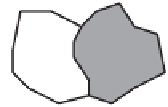Information Technology Reference
In-Depth Information
Box 2.1
Drawing the maps
For the mapping in this topic a program was written, in
1989, to perform automated cartography. The program com-
bined information from geometry and lookup data files with
CSV text files describing the topology and other attributes
of places, to produce the desired map as a drawfile, which
could then be manipulated further. The shading and names
of places was given in the text file and a set of simple rules
applied to annotate the areas. Names were split at spaces,
hyphens, commas, before the syllable 'shire' and wherever an underscore
had been inserted. The text was then scaled to fit in a rectangle within the
place and centred.
Oxford
shire
Places could be represented by complex 'paths'
rather than simple polygons, so all the islands and lochs
of Western Scotland were easily combined as a sin-
gle list of the boundaries of Strathclyde. Paths could
also overlap and the space covered did not have to be
completely allocated to areal units, as it often does in
traditional GIS systems. The places did not have to be given in any partic-
ular order as each was tagged in the drawfile with an identification code,
permitting many other graphical possibilities, which will be shown later.
Creating the maps as drawfiles also meant that they could be produced
on almost any printer available or dragged into documents such as this.
2.2 Why study places?
People live in different worlds even though they share the same local-
ity: there is no single community or quarter. What is pleasantly 'old'
for one person is decayed and broken for another.
(Wright, 1989, p. 290)
Place matters to the relationships between people (Figure 2.4). Just as your
place in time so obviously constrains and determines your life, so your place
in space limits and creates the possibilities in your world. It is not the actual
position in space, as it is not the actual position in time that does this, but who
shares that place, who shares your time.
However, times and places are fundamentally different things. As we live
we must all share the same moment in time, but, in existing, must be spread
over space into different places. This diffusion of settlement in space, juxtaposed
with the concentration in time, defines the dimensions over which experiences








Search WWH ::

Custom Search